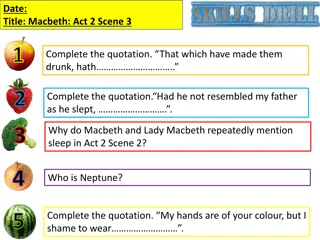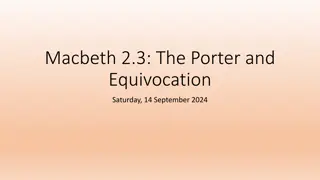Analysis of "Rope" by Katherine Anne Porter
Katherine Anne Porter's short story "Rope" explores the frustrations and lack of communication in a married couple's relationship. The story delves into the dynamics of an unhappy marriage, symbolized by a coil of rope, highlighting the struggles of understanding and mutual respect between partners. Through intense arguments and symbolic imagery, Porter portrays the entwined misery and loneliness that can result from failing to connect with one's spouse.
Download Presentation

Please find below an Image/Link to download the presentation.
The content on the website is provided AS IS for your information and personal use only. It may not be sold, licensed, or shared on other websites without obtaining consent from the author.If you encounter any issues during the download, it is possible that the publisher has removed the file from their server.
You are allowed to download the files provided on this website for personal or commercial use, subject to the condition that they are used lawfully. All files are the property of their respective owners.
The content on the website is provided AS IS for your information and personal use only. It may not be sold, licensed, or shared on other websites without obtaining consent from the author.
E N D
Presentation Transcript
By Ms Shahzaib Ch (semester IV) English Lit (Minor) Rope By Katherine Anne Porter
Introduction: Katherine Anne Porter was an American journalist, essayist, short story writer, novelist, and political activist. Porter is examining circumstances in which a woman of her own background and social standing might find herself, trapped in an unhappy marriage and personally limited by the attitudes and values of her spouse. The man and the woman in 'Rope' are unnamed and undescribed. Since "Rope" does illuminate the husband's feelings more than the wife's, she concludes the storyteller is most likely the husband and that "Rope" is the story of a wife's frustrations and of her husband's inability to understand and comprehend them. The story Rope effectively describes the hidden frustration of a married couple that is caused by lack of communication by presenting a bundle of rope as a symbol.
Main Idea: A married couple hang themselves with words in Katherine Anne Porter's short story "Rope," which details a heated argument, in a setting that is unfamiliar to both opponents, over a coil of rope and some forgotten coffee. Porter, who suffered several failed relationships of her own, seems to be diagramming not only a marital upheaval but also the frustrated discovery that all couples experience when partners reveal selfishly real motivations. The rope becomes a symbolic chain that joins them in misery, a noose that mentally lynches both as one. "It was the rope again," says Porter, invoking marital doom. Their spat reveals numerous "hot buttons" in the relationship: her hatred of the home, his hatred of her impatience, their detestation of each other. The tale's balance is remarkable: the couple never understand each other's thought processes, although we see them perfectly, and their mutual tone moves from annoyance to spite to white-hot anger.
Significance of Title: The rope itself is symbolic because rope can tie things together which seems to be the case in the story. Both the husband and the wife are bound (by marriage) to each other, whether they like it or not. "Rope" effectively demonstrates what can happen in a relationship without mutual respect and a conscious effort to understand the other's point of view. Unfortunately, these "fated" relationship are not uncommon in our society. Often minor disagreements escalate into domestic violence. Gender roles and perceptions, though radically evolving, continue to sabotage otherwise healthy and mutually beneficial liaisons.
Themes: Insecurity Love Resentment Connection Commitment Struggle Paralysis Lack of communication
Conclusion: Porter delineates circumstances in which a wife is caught in an unhappy marriage and completely frustrated by the situation surrounding her. The wife experiences financial distress and anxiety over her unfaithful husband and personality conflict. The story that is based on the quarrel of a married couple shows that a small dispute that happens in everyday life can be an opportunity to express cumulative complaints. The trivial argument about coffee and rope becomes a serious squabbling. The irony is that neither party cares for the other, any more than they care about the useless rope.























